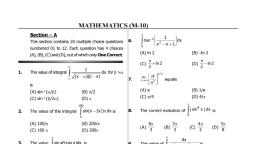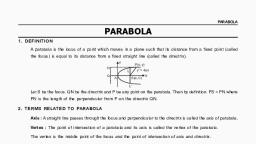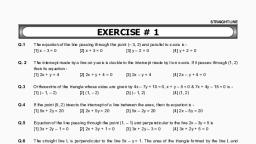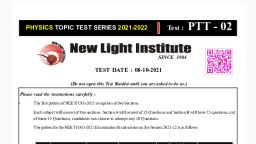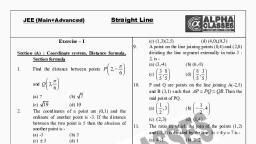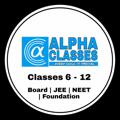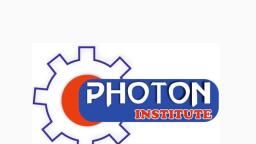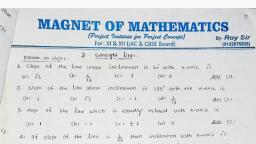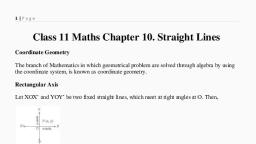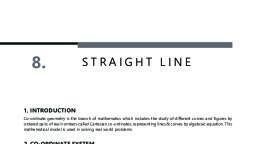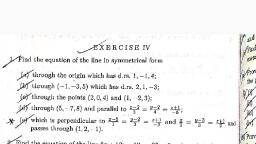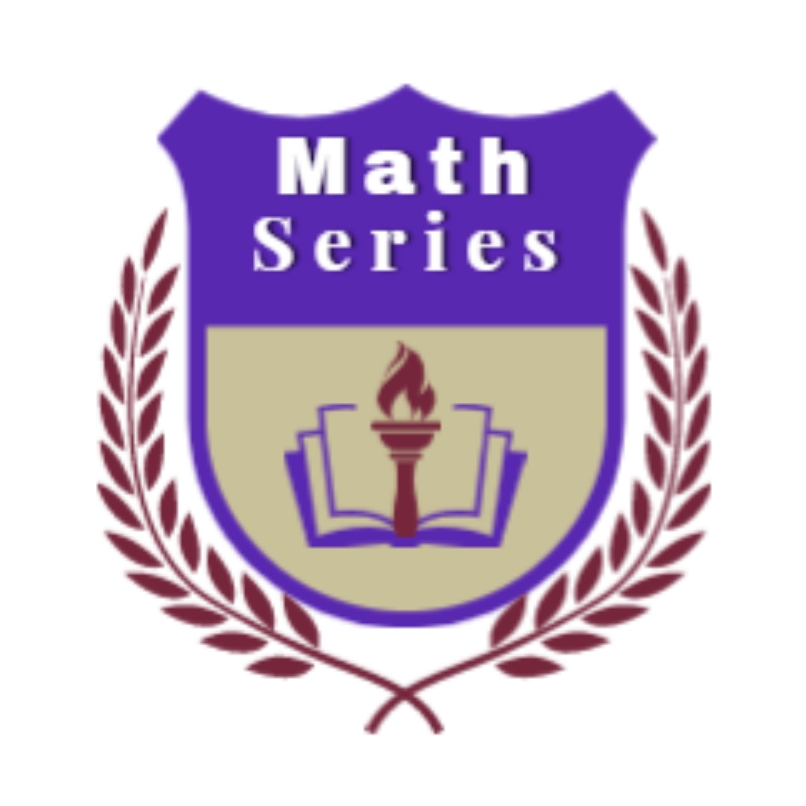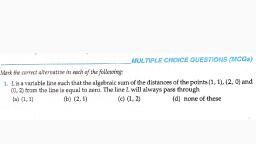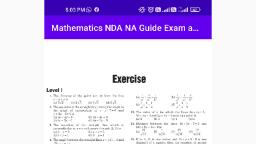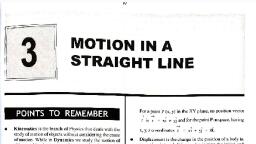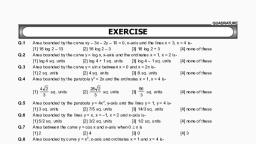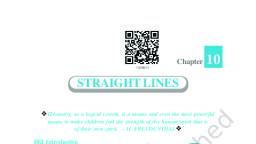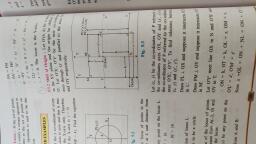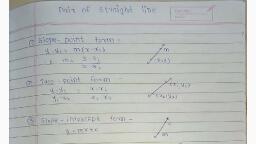Page 1 :
STRAIGHT LINE, , EXERCISE # 1, Q.1, , The equation of the line passing through the point (– 3, 2) and parallel to x axis is [1] x – 3 = 0, [2] x + 3 = 0, [3] y – 2 = 0, [4] y + 2 = 0, , Q. 2, , The intercept made by a line on y-axis is double to the intercept made by it on x-axis. If it passes through (1, 2), then its equation [1] 2x + y = 4, [2] 2x + y + 4 = 0, [3] 2x – y = 4, [4] 2x – y + 4 = 0, , Q.3, , Orthocentre of the triangle whose sides are given by 4x – 7y + 10 = 0, x + y – 5 = 0 & 7x + 4y – 15 = 0 is [1] (– 1, – 2), [2] (1, – 2), [3] (– 1, 2), [4] (1, 2), , Q.4, , If the point (5, 2) bisects the intercept of a line between the axes, then its equation is [1] 5x + 2y = 20, [2] 2x + 5y = 20, [3] 5x – 2y = 20, [4] 2x – 5y = 20, , Q.5, , Equation of the line passing through the point (1, – 1) and perpendicular to the line 2x – 3y = 5 is, [1] 3x + 2y – 1 = 0, [2] 2x + 3y + 1 = 0, [3] 3x + 2y – 3 = 0, [4] 3x + 2y + 5 = 0, , Q.6, , The straight line L is perpendicular to the line 5x – y = 1. The area of the triangle formed by the line L and, coordinates axes is 5. Then the equation of the line will be [1] x + 5y = 5 2 or x + 5y = – 5 2, , [2] x – 5y = 5 2 or x – 5y = 5 2, , [3] x + 4y = 5 2 or x – 2y = 5 2, , [4] 2x + 5y = 5 2 or x + 5y = 5 2, , Q.7, , The equation of the line passing through the point of intersection of the line 4x – 3y – 1 = 0 and 5x – 2y – 3 = 0, and parallel to the line 2x – 3y + 2 = 0 is [1] x – 3y = 1, [2] 3x – 2y = 1, [3] 2x – 3y + 1 = 0, [4] 2x – y = 1, , Q.8, , The length of perpendicular from (2, 1) on line 3x – 4y + 8 = 0 is, [1] 5, [2] 4, [3] 3, , [4] 2, , Q.9, , The co-ordinate of foot of a perpendicular drawn on line 3x – 4y – 5 = 0 to the point (0, 5) is [1] (1, 3), [2] (2, 3), [3] (3, 2), [4] (3, 1), , Q.10, , The equation of straight line passing through the point of intersection of the lines x – y + 1 = 0 and 3x + y – 5 = 0, and perpendicular to one of them is [1] x + y – 3 = 0 or x – 3y + 5 = 0, [2] x – y + 3 = 0 or x + 3y + 5 = 0, [3] x – y – 3 = 0 or x + 3y – 5 = 0, [4] x + y + 3 = 0 or x + 3y + 5 = 0, , Q.11, , Find the fix point through which the line (2cos + 3 sin)x + (3cos – 5sin) y – (5cos – 2sin) = 0 passes for, all values of [1] (0, 0), [2] (1, 1), [3] (2, 1), [4] none of these, The equations of the lines on which the perpendiculars from the origin make 30º angle with x axis and which form, , Q.12, , 50, a triangle of area, [1] x ±, , 3, , 3 y – 10 = 0, , with axes, are [2], , 3 x + y ± 10 = 0, , [3] x +, , 3 y ± 10 = 0, , [4] none of these, , Mathematics By Goyal Sir....9829652673, , 41
Page 2 :
STRAIGHT LINE, , Q.13, , If the foot of the perpendicular from the origin to a straight line is at the point (3, – 4). Then the equation of the line, is [1] 3x – 4y = 25, [2] 3x – 4y + 25 = 0, [3] 4x + 3y – 25 = 0, [4] 4x – 3y + 25 = 0, , Q.14, , A line passes through the point (1, 2) and makes 60º angle with x axis. A point on this line at a distance 3 from, the point (1, 2) is - [1] (– 5/2, 2 – 3 3 /2), , [2] (3/2, 2 +, , 3 /2), , [3] (5/2, 2 + 3, , 3 /2), , [4] none of these, , Q.15, , If (0, 0), (– 2, 1) and (5, 2) are the vertices of a triangle, Then equation of line passing through its centroid and, parallel to the line x – 2y = 6 is [1] x – 2y = 1, [2] x + 2y + 1 = 0, [3] x – 2y = 0, [4] x – 2y + 1 = 0, , Q.16, , The equation of the bisector of the acute angle between the lines 3x – 4y + 7 = 0 and 12x + 5y – 2 = 0 is [1] 11x – 3y – 9 = 0, [2] 11x – 3y + 9 = 0, [3] 21x + 77y – 101 = 0 [4] none of these, , Q.17, , The vertices of a triangle are (2, 1), (5, 2) and (4, 4). Then lengths of the perpendicular from these vertices on the, opposite sides are -, , 7, [1], , 6, , 7, ,, , 8, , 7, ,, , 10, , 7, [2], , 5, , 7, ,, , 13, , 7, ,, , 6, , 7, [3], , 5, , 7, ,, , 8, , 7, ,, , 15, , 7, [4], , 5, , 7, ,, , 13, , 7, ,, , 10, , Q.18, , A variable line rotates in such a way that sum of intercepts made by the line on axes is always a constant c. The, locus of mid point of intercept made by the line with axes is [1] 2 (x + y) = c, [2] x + y = c, [3] x + y = 2c, [4] x2 + y2 = c2, , Q.19, , If the intercept of a line between coordinate axes is bisected at the point (2, 2), then its equation is [1] x + y = 4, [2] 2x + y = 6, [3] x + 2y = 6, [4] 3x – y = 4, , Q.20, , If the lines ax + 2y + 1 = 0, bx + 3y + 1 = 0, cx + 4y + 1 = 0 are concurrent, then a, b, c are in [1] AP, [2] GP, [3] HP, [4] None of these, , Q.21, , Consider the lines 2x + 3y = 7, 2x + 3y = 12 and point A(3, – 5). Then [1] A lies between the lines, , [2] Sum of perpendicular distance from A to the lines = 5 / 13, , [3] Distance between lines is 19/ 13, , [4] None of these, , Q.22, , If the coordinates of the points A, B, C be (– 1, 5), (0, 0) and (2, 2) respectively and D be the middle point of BC,, then the equation of the perpendicular drawn from B to the line AD is [1] 2x + y = 0, [2] x + 2y = 0, [3] x – 2y = 0, [4] 2x – y = 0, , Q.23, , Given p > q > r > 0. Then the area of the triangle formed by joining the points (ap2, ap), (aq2 ,aq), (ar2, ar) is, , a2, [1], (p – q) (q – r)(p – r), 2, [3], , a2, pqr, 2, , a2, [2], (p + q)(q + r)(p + r), 2, [4] None of these, , Mathematics By Goyal Sir....9829652673, , 42
Page 3 :
STRAIGHT LINE, , Q.24, , The straight lines ax + by + c = 0 where 3a + 2b + 4c = 0 are concurrent at the point [1] (1/2, 3/4), [2] (3/4, 1/2), [3] (– 3/4, – 1/2), [4] (–3/4, 1/2), , Q.25, , If the line 3x – 2y = 9 meets the axes at A and B, then OBA is equal to [1] tan–1 3/2, [2] tan–1 2/3, [3] tan–1 1/3, [4] 45º, , Q.26, , The straight line through the point of intersection of ax + by + c = 0 and a'x + b'y + c' = 0 and parallel to the y axis, has the equation [1] x(ab' – a'b) + (cb' – c'b) = 0, [2] x(ab' + a'b) + (cb' + c'b) = 0, [3] y (a'b – ab') + (a' c – ac') = 0, [4] None of these, , Q.27, , The equation of the line which bisects the obtuse angle between the lines x – 2y + 4 = 0 and 4x – 3y + 2 = 0, is, , Q.28, , [1] (4 –, , 5 )x – (3 – 2 5 )y + (2 – 4 5 ) = 0, , [3] (4 +, , 5 ) x – (3 + 2 5 ) y + (2 + 4 5 ) = 0 [4] none of these, , [2] (4 +, , 5 ) x + (3 + 2 5 ) y + (2 + 4 5 ) = 0, , The Straight line x = a and x2 – 3y2 = 0 encloses a triangle which is [1] Isosceles, [2] Right angled, [3] Equilateral, , [4] None of these, , Q.29, , If the two lines are represented by equation x2 + 2y2 – 5xy + 5x – 7y + 3 = 0, then equal to, [1] 3, [2] – 3, [3] 2, [4] – 2, , Q.30, , If the equation x2 + y2 + 2gx + 2fy + 1 = 0 represents a pair of lines, then [1] f2 + g2 = 1, [2] g2 – f2 = 1, [3] f2 – g2 = 1, [4] f2 + g2 = 1/2, , Q.31, , Equation of the pair of straight lines through origin and perpendicular to the pair of straight lines 5x2 – 7xy – 3y2 = 0 is, [1] 3x2 – 7xy – 5y2 = 0 [2] 3x2 + 7xy + 5y2 = 0 [3] 3x2 – 7xy + 5y2 = 0 [4] 3x2 + 7xy – 5y2 = 0, , Q.32, , The equation of the line passing through the point (c, d) and parallel to the line ax + by + c = 0 is, [1] a (x + c) + b (y + d) = 0, [2] a (x + c) – b (y + d) = 0, [3] a (x – c) + b (y – d) = 0, [4] none of these, , Q.33, , The equation of a line perpendicular to the line 5x – 2y + 7 = 0 and passing through the point of intersection of, lines y = x + 7 and x + 2y + 1 = 0, is, [1] 2x + 5y = 0, [2] 2x + 5y = 20, [3] 2x + 5y = 10, [4] none of these, , Q.34, , The line ( 3x – y + 5) + (2x – 3y – 4) = 0 will be parallel to y – axis, if =, [1] 1/3, , Q.35, , [2], , 2x y 1, , [4] –3/2, , 2 form the origin. Its equation is, , [3] y – x = 2, , [4] y – x =, , 2, , If the point (3, –4) divides the intercept of a line between coordinate axes in the ratio 2 : 3 , then its equation is, [1] 2x + 3y + 1 = 0, , Q.37, , [3] 3/2, , A line makes 45° angle with x-axis and at a distance, [1] x y 2 1, , Q.36, , [2] –1/3, , [2] 3x – 4y + 1 = 0, , [3] 2x – 3y = 5, , [4] 2x – y = 10, , The equation of a line passing through the origin and the point (a cos , a sin ) is, [1] y = x cos , , [2] y = x tan , , [3] y = x sin , , [4] y = x cot , , Mathematics By Goyal Sir....9829652673, , 43
Page 4 :
STRAIGHT LINE, , Q.38, , If a line passes through the point P(1,2) makes an angle of 45° with the x axis and meets the line x + 2y –7 = 0, at Q, then PQ equals, [1], , Q.39, , 2 2, 3, , [2], , 3 2, 3, , [3], , [4], , 3, , 2, , A line meets the axes at points A and B such that the centroid of OAB is the point ( a, b), then the equation of, the line is, [1], , Q.40, , Q.41, , Q.42, , x y, 1, a b, , [3], , x y, 3, a b, , [1] t1 t2 y + x = a (t1+ t2), , [2] t1 t2 y + x = 2a (t1+ t2), , [3] t1 t2 x + y = a (t1+ t2), , [4] None of these, , [4], , x y, 4, a b, , The equation of the line which cuts off the intercepts 2a sec and 2a coses on the axes is, [1] x sin + y cos – 2a = 0, , [2] x cos + y sin – 2a = 0, , [3] x sec + y cosec – 2a = 0, , [4] x cosec + y sec – 2a = 0, , The length of the segment of the line 3x – 4y = 5 between the coordinates axes is, [2] 5/4, , [3] 5/12, , [4] 25/12, , If the lines ax – y – b = 0 and x – 2by + a = 0 meet at the point ( 1,2) then, [1] a = 1 , b = 3, , Q.44, , x y, 2, a b, , , , a, a, The equation of the line passing through the points at1 , t and at 2 , t is, 1, 2 , , , , [1] 5/3, Q.43, , [2], , [2] a = 3 , b = – 1, , [3] a = 3 , b = 1, , [4] a = –3 , b = 1, , For a variable line x/a + y/b =1 , a + b = 10, the locus of mid point of the intercept of this line between coordinate, axes is, [1] 10x + 5y = 1, , Q.45, , [2] x + y = 10, , [3] x + y = 5, , [4] 5x + 10y = 1, , A straight line cuts intercepts from the coordinate axes sum of those reciprocals is 1/p. It pases throught a fixed, point, [1] (1/p, p), , Q.46, , [3] ( 1/p, 1/p), , b2 a2, 2, , 1, [2] tan, , a2 b2, ab, , 1, [3] tan, , b 2 a2, 2ab, , [4] None of these, , The equation of a line passing through the point (a , b) and perpendicular to the line ax + by + c = 0 is, [1] bx – ay + (a2 – b2) = 0 [2] bx – ay – (a2 –b2) = 0 [3] bx – ay = 0, , Q.48, , [4] ( p , p), , The angle between the lines whose intercepts on the axes are a, –b and b, –a respectively, is 1, [1] tan, , Q.47, , [2] (p , 1/p), , [4] None of these, , The equation of the line parallel to the line 2x – 3y = 1 and passing through the middle point of the line segment, joining the points ( 1, 3) and ( 1, –7), is, [1] 2x – 3y + 8 = 0, , Q.49, , [3] 2x – 3y + 4 = 0, , [4] 2x – 3y = 4, , If the lines x – y + p = 0, –x + y = 0 and 5y + 6 = 0 are concurrent then the value of p is, [1] –1, , Q.50, , [2] 2x – 3y = 8, , [2] 1, , [3] 2, , [4] 0, , If the lines ax + by + c = 0 , bx + cy +a = 0 and cx + ay + b = 0 be concurrent, then, [1] a3 + b3 +c3 –abc = 0, , [2] a3 +b3 +c3 + 3abc = 0, , [3] a3 + b3 + c3 – 3abc = 0, , [4] None of these, , Mathematics By Goyal Sir....9829652673, , 44
Page 5 :
STRAIGHT LINE, , Q.51, , The lines, (p – q) x + (q – r) y + (r – p) = 0, (q – r) x + (r – p) y + (p – q) = 0, (r – p) x + (p – q) y + (q – r) = 0 are, [1] Parallel, , Q.52, , [2] Perpendicular, , [2] 11/13, , [2] 1, , [4] 13/22, , [3] 3 / 5, , [4] 17 5 / 15, , The ratio in which the line 3x + 4y + 2 = 0 divides the distance between 3x + 4y + 5 = 0 and 3x + 4y – 5 = 0, is, [1] 7 : 3, , Q.55, , [3] 22/13, , The distance between the parallel lines y = 2x + 4 and 6x = 3y + 5 is, [1] 17 3, , Q.54, , [4] None of these, , The distance between the lines 5x + 12y + 13 = 0 and 5x + 12y = 9 is, [1] 22/17, , Q.53, , [3] Concurrent, , [2] 3 : 7, , [3] 2 : 3, , [4] None of these, , For the straight lines given by the equation ( 2 + k)x + ( 1 +k)y = 5 + 7k, for different values of k which of the, following statement is true, , Q.56, , [1] lines pass through the point ( 2 , –9), , [2] lines pass through the point ( –2, 9), , [3] lines are parallel, , [4] none of these, , If a,b,c are in A.P. , then ax + by +c = 0 will always pass through a fixed point whose coordinates are, [1] (1, –2), , Q.57, , [2] (–1, 2), , [2] ( 2, 1), , [2] 4, , [4] None of these, , [3] 2, 2, , [4] 3, , 2, , 2, , If slope of lines represented by ax + 2hxy + by = 0 , are in 1 : 3 ratio then h : ab equals, , 3, 4, , [1], Q.60, , [3] (1 , 1), , If ax2 + 6xy + by2 – 10x + 10y –6 = 0 represents two perpendicular lines, then |a| equals, [1] 1, , Q.59, , [4] (–1,–2), , The points of intersection of lines represented by the curve 2x2 + 3xy + y2 – 7x – 5y + 6 = 0 is –, [1] (1, –1), , Q.58, , [3] (1 ,2), , [2], , 1, 4, , [3], , 4, 3, , [4] None of these, , The difference of the tangents of the angles which the lines x2(sec2 – sin2) – 2xy tan + y2 sin2 = 0 makes with, the x axis is, [1] 2, , Q.61, , [3] 2 tan, , [4] sin2, , If sides of a triangle are y = mx + a, y = nx + b and x = 0, then its area is, [1], , Q.62, , [2] 2 cot, , 1 a b , , 2, , 1 a b , , 2, , 2, , [3], [4] none of these, 2 m n, 2m n, A line moves in such a way that the sum of the intercepts made by it on the axes is always c (constant). The, , 2 m n, , [2], , a b, , locus of the mid point of its intercept between the axes is, [1] x + y = 2c, Q.63, , [2] x + y = c, , [3] 2(x + y) = c, , [4] None of these, , The lines PQ whose equation is x – y = 2 cuts the x axis at P and Q is (4,2). The line PQ is rotated about P, through 45° in the anticlockwise direction. The equation of the line PQ in the new position is, [1] y = – 2, , [2] y = 2, , [3] x = 2, , [4] x = –2, , Mathematics By Goyal Sir....9829652673, , 45
Page 6 :
STRAIGHT LINE, , EXERCISE # 2, Q.1, , A vertex of an equilateral triangle is (2, 3) and the equation of the opposite side is x + y = 2. Find the equations, of the other sides of the triangle., [1] y – 3 = (2 ±, , 3 ) (x – 2), , [2] y – 3 = (4 ±, , 3 ) (x + 2), , [3] y – 3 = (2 ±, , 3 ) (x + 4), , [4] y – 3 = (6 ±, , 3 ) (x – 2), , Q.2, , The angle between the lines x cos1 + y sin1 = p1 , x cos2 + y sin2 = p2 is, [1] (1 + 2), [2] (1 – 2), [3] 22, [4] 21, , Q.3, , The equation of the bisector of the angle between the lines 3x – 4y + 7 = 0 and 12x – 5y – 8 = 0 is [1] 99x – 77y + 51 = 0, 21x + 27y – 131 = 0, [2] 99x – 77y + 51 = 0, 21x + 27y + 131 = 0, [3] 99x – 77y + 131 = 0, 21x + 27y – 51 = 0, [4] none of these, , Q.4, , Find the equation of a straight line passing through the point (4, 5) and equally inclined to the lines 3x = 4y + 7, and 5y = 12x + 6, [1] 9x – 7y = 1 and 7x + 9y = 73, [2] 8x + 7y = 1 and 7x – 9y = 75, [3] 6x – 7y = 1, 6x + 9y = 73, [4] none of these, , Q.5, , Find the fix point through which the line x(a + 2b) + y(a + 3b) = a + b always passes for all values of a and b, [1] (2, 1), [2] (1, 2), [3] (2, – 1), [4] (1, – 2), , Q.6, , The equation of the line which passes through (a cos 3 ,a sin 3 ) and perpendicular to the line, x sec + y cosec) = a is, [1] x cos + ysin = 2a cos2, [2] x sin – y cos = 2a sin2, [3] x sin + y cos = 2a cos 2, [4] x cos – y sin = a cos 2, , Q.7, , The area of the parallelogram formed by the lines 4y – 3x = 1, 4y – 3x – 3 = 0, 3y – 4x + 1 = 0, 3y – 4x + 2 = 0, is, [1] 3/8, [2] 2/7, [3] 1/6, [4] none of these, , Q.8, , (1, 2) is vertex of a square whose one diagonal is along the x-axis. The equations of sides passing through the, given vertex are [1] 2x – y = 0, x + 2y + 5 = 0, [2] x – 2y + 3 = 0, 2x + y – 4 = 0, [3] x – y + 1 = 0, x + y – 3 = 0, [4] none of these, , Q.9, , If one of the diagonals of a square is along the x = 2y and one of its vertices is (3, 0), then its sides through this, vertex are given by the equations [1] y – 3x + 9 = 0, 3y + x – 3 = 0, [2] y + 3x + 9 = 0, 3y + x – 3 = 0, [3] y – 3x + 9 = 0, 3y – x + 3 = 0, [4] y – 3x + 3 = 0, 3y + x + 9 = 0, , Q.10, , The equation of the lines which pass through the origin and are inclined at an angle tan–1 m to the line, y = mx + c, are [1] y = 0, 2mx + (1 – m2) y = 0, [2] y = 0, 2mx + (m2 – 1) y = 0, [3] x = 0, 2mx + (m2 – 1) y = 0, [4] none of these, , Q.11, , A variable line passes through a fixed point (a, b) and meets the coordinates axes in A and B. The locus of the, point of intersection of lines through A, B parallel to coordinate axes is [1] x/a + y/b = 2, [2] a/x + b/y = 1, [3] x/a + y/b = 1, [4] x/a + y/b = 3, , Mathematics By Goyal Sir....9829652673, , 46
Page 7 :
STRAIGHT LINE, , Q.12, , The diagonal of the parallelogram whose sides area x + my + n = 0, x + my + n' = 0 mx + y + n = 0, mx + y + n' = 0, include an angle -, , 2m , [1] tan 2, 2 , m , , [2] tan, , [3] /2, , [4] /3, , –1, , Q.13, , –1, , 2 m2 , 2, 2 , m , , The product of perpendiculars drawn from the point ( a2 b2 ,0) to the line x/a cos + y/b sin = 1 is [1] a2 – b2, , [2] a2 + b2, , [3] a2, , [4] b2, , Q.14, , The ends of the base of an isosceles triangle are at (2a, 0) and (0, a) and one side is parallel to y-axis. The, equation of the other side is [1] x + 2y – a = 0, [2] x + 2y = 2a, [3] 3x + 4y – 4a = 0, [4] 3x – 4y + 4a = 0, , Q.15, , If the acute angles between the pairs of lines 3x2 – 7xy + 4y2 = 0 and 6x2 – 5xy + y2 = 0 be 1 and 2 respectively,, then [1] 1 = 2, [2] 21 = 2, [3] 1 = 22, [4] none of these, , Q.16, , Orthocentre of the triangle whose vertices are (0, 0), (2, – 1) and (1, 3) is [1] (– 4, – 1), , 4 1, , 7 7, , [2] , , 4 1, , , 7 7, , [3] , , [4] (4, 1), , Q.17., , x2 – 3xy + y2 + 3x – 5y + 2 = 0 representes a pair of lines where is a real number. If be the angle between, these lines, then cosec2 equals [1] 9, [2] 3, [3] 10, [4] 100, , Q.18, , If one line of the pair of lines ax2 + 2hxy + by2 = 0 bisects the angle between coordinates axes in positive, quadrant, then, [1] a – b = 2 |h|, [2] a + b = – 2h, [3] a + b = 2 |h|, [4] (a – b)2 = 4h2, , Q.19, , The points on the line x + y = 4 which lie at a unit distance from the line 4x + 3y = 10, are [1] (3, 1) (– 7, 11), [2] (– 3, 1), (– 7, 11), [3] (3, 1), (7, 11), [4] (1, 3), (– 7, 11), , Q.20, , If , , are three different values then equation ( – )x + ( – ) y + ( – ) = 0 and (3 – 3)x + (3 – 3) y + (3 – 3) = 0, represents same line if [1] = – ( + ), [2] + + = 1, [3] = + , [4] none of these, , Q.21, , The equation of the lines which passes through the point (3, – 2) and are inclined at 60º to the line, , Q.22, , [1] y + 2 = 0,, , 3x–y–2–3, , [3] x – 2 = 0,, , 3 x–y+2+3, , 3 =0, 3 =0, , [2], , 3x–y–2–3, , 3x+y=1, , 3 =0, , [4] none of these, , If the lines y = 3x + 1 and 2y = x + 3 are equally inclined to the line y = mx + 4 , then m =, [1], , 1 3 2, 7, , [2], , 1 3 2, 7, , [3], , 1 3 2, 7, , [4], , 1 5 2, 7, , Mathematics By Goyal Sir....9829652673, , 47
Page 8 :
STRAIGHT LINE, , Q.23, , In the equation y–y1 = m (x –x1) if m and x1 are fixed and different lines are drawn for different values of y1, then, ; ( where m ), , Q.24, , [1] There will be one line only, , [2] There will be a set of parallel lines, , [3] The lines will pass through the single point, , [4] none of these, , A stragiht line is parallel to the lines 3x – y – 3 = 0 and 3x – y + 5 = 0 and lies between them. If its distance from, these lines are in the ratio 3 : 5 , then its equation will be, [1] 3x – y + 1 = 0, , Q.25, , [2] 3x – y + 2 = 0, , [3] 3x – y = 0, , [4] none of these, , In the equation y – m1x – c1 + (y –m2x –c2 ) = 0 , is a variable quantity which may have any value. Then the, straight line represented by this equation passes through the fixed point., , Q.26, , c1 c 2 m1c 2 m2c1 , [1] m m , m m , 1, 2, 1, 2, , , c 2 c1 m1c 2 m2c1 , [2] m m , m m , 1, 2, 1, 2, , , c1 c 2 m1c 2 m2c1 , [3] m m , m m , 1, 2, 1, 2, , , [4] None of these, , The line 3x + 2y = 24 meets y-axis at A and x–axis at B. The perpendicular bisector of AB meets the line through, ( 0,–1) parallel to x-axis at C. The area of the triangle ABC is, [1] 182 sq. units, , Q.27, , [2] 91 sq. units, , [3] 48 sq. units, , [4] None of these, , Let the base of a triangle lie along the line x =a and be of length 2a. The area of triangle is a2, if the vertex lies on, the line, [1] x = a /2, , Q.28, , [3] x = –a, , [4] x = a / 4, , The locus of the point of intersection of the lines xcos + y sin = a and x sin – y cos = b is, [1] x2 – y2 = a2 – b2, , Q.29, , [2] x = 0, , [2] x2 – y2 = a2 + b2, , [3] x2 + y2 = a2 – b2, , [4] x2 + y2 = a2 + b2, , A point moves so that square of its distance from the point ( 3, –2) is numerically equal to its distance from the, line 5x – 12y = 13. The equation of the locus of the point is, , Q.30, , [1] 13x2 + 13y2 – 83x + 64y + 182 = 0, , [2] x2+ y2 – 11x + 16y + 26 = 0, , [3] x2 + y2 – 11x + 16y = 0, , [4] None of these, , Let line L be 2x + y = 2. If coordinate axes be rotated at 45° angle then the lengths of the intercepts of L on new, axes will be, [1], , Q.31, , 2 ,1, , [2] 1, 2, , [3] 2 2 ,2 2 / 3, , [4] 2 2 / 3 ,2 2, , If the algebric sum of the perpendicular distances from the points ( 2 , 0) , ( 0 ,2) and ( 1, 1) to a variable straight, line be zero. Then find the coordinate through which the line passes, [1] ( 1 , 1), , [2] ( 0 , 0), , [3] ( 3 , 2), , [4] ( 2 , 3), , Mathematics By Goyal Sir....9829652673, , 48
Page 9 :
STRAIGHT LINE, , EXERCISE # 3, Q.1, , A ( 1, 3) and C( 5 , 1) are two opposite vertices of a rectangle. If the slope of the line on which the other two, vertices B and D lie is 2, then the equation of BD is, [1] 2x – y = 4, , Q.2, , 2, [2] p , , 1, 1, 2, 2, a b, , [2] 3x + 4y + 8 = 0, , [2] x – y = 2, , The equation of the line perpendicular to the line, x -axis is, [1], , Q.7, , [3] (0 , –1), , [4] (–9 , –4), , 1, 1 1, [3] p2 a2 b2, , [RPET 94 ], , [4] none of these, , [3] 3x + 4y = 10, , x y a, 0, a b b, , [2], , x y b, , b a a, , [3] x + y + 2 = 0, , [RPET 95 ], [4] x + y = 2, , x y, 1 and passing through the point at which it cuts, a b, [RPET- 1996], , [3], , x y, 0, b a, , [4], , x y a, , b a b, , A straight line segment of length moves with its ends on the coordinate axes. The locus of the point which, divides the line in the ratio 1 :2 is, [1] 9x2 + 36y2 = 2, , Q.8, , [2] 36x2 + 9y2 = 2, , [RPET 97 ], [3] 36x2 + 9y2 = 42, , [4] 9x2 + 36y2 = 42, , The system of lines ax + by +c = 0 where 3a + 2b + 4c = 0, passes through the point, [1] (0 , 0), , Q.9, , [2] (1/2, 3/4), , [3] ( 3/4 , 1/2), , If the base of an equilateral triangle is x + y = 2 and its opposite vertex is ( 2 ,1), then the length of its each side, , [1] 2/3, , [RPET 99 ], [2] 3/2, , [3], , 3/2, , [4], , 2/3, , If for the variable line x/a + y/b = 1, the relation 1/a2 + 1/b2 = 1/c2 ( c constant) is satisfied, then the locus of the, foot of the perpendicular from the origin on this line is, [1] x2 + y2 = c2, , Q.11, , [RPET 99 ], , [4] none of these, , is, , Q.10, , [RPET 95 ], , [4] 3x + 4y = 1, , The equation of a line passing through ( 4, –2) an ( –1, 3) is, [1] x + y = 0, , Q.6, , [2] (–1, –4), , [RPET 91 ], , Equation of the line passing through (4, –5) and parallel to the line 3x + 4y + 1 = 0 is, [1] 3x + 4y = 8, , Q.5, , [4] 2x + y =1, , If p be the length of the perpendicular from the origin on the line x/a + y/b = 1 , then, [1] p2 = a2 + b2, , Q.4, , [3] 2x + y = 4, , The reflection of the point ( 3, 8) with respect to the line x + 3y = 7 is, [1] ( 5 , –6), , Q.3, , [2] 2x – y = 1, , [RPET 91 ], , [2] x2 + y2 = 2c2, , [3] 2(x2 + y2) = c2, , [RPET 99 ], [4] None of these, , If a + b + c = 0, then line 3ax + 4by + c = 0 passes through the fixed point, [1] ( 1/3, –1/4), , [2] (–1/3 , 1/4), , [3] ( 1/3, 1/4), , [RPET 02 ], [4] (–1/3, –1/4), , Mathematics By Goyal Sir....9829652673, , 49
Page 10 :
STRAIGHT LINE, , Q.12, , The diagonals of a parallelogram PQRS are along the lines x + 3y = 4 and 6x – 2y = 7 . Then PQRS must be a, [IIT 1998 ], [1] Rectangle, , Q.13, , [2] Square, , [3] Cyclic quadrilateral, , [4] Rhombus, , Let PQR be a right angled isosceles triangle right angled at P(2, 1). If the equation of the line QR is 2x + y = 3,, then the equation representing the pair of lines PQ and PR is, , Q.14, , [IIT 99], , [1] 3x2 – 3y2 + 8xy + 20x + 10y + 25 = 0, , [2] 3x2 – 3y2 + 8xy – 20x – 10y + 25 = 0, , [3] 3x2 – 3y2 + 8xy + 10x + 15y + 20 = 0, , [4] 3x2 – 3y2 – 8xy – 10x – 15y – 20 = 0, , Let PS be the median of the triangle with vertices P(2, 2), Q(6, –1) and R(7, 3). The equation of the line passing, through (1, –1) and parallel to PS is[1] 2x – 9y – 7 = 0, , Q.15, , [3] 2x + 9y – 11 = 0, , [4] 2x + 9y + 7 = 0., , All vertices of PQR lie on the circle x2 + y2 = 25. If Q (3, 4) and R (–4, 3), then QPR is equal to, [1] /2, , Q.16, , [2] 2x – 9y – 11 = 0, , [IIT 2000], , [2] /3, , [3] /4, , [4] /6, , [IIT 2000], , If the abscissa of the point of intersection of lines 3x + 4y = 9 and y = mx + 1 is an integer then number of integer, values of m is, [1] 2, , Q.17, , [2] 0, , [3] 4, , [4] 1, , Area of the parallelogram formed by the lines y = mx, y = mx + 1, y = nx and y = nx + 1 equals, [1], , Q.18, , [IIT 2001], , |mn|, (m n), , 2, , 2, [2] | m n |, , [3], , 1, (m n), , 1, [4] | m n |, , If a line passing through the origin O meets parallel lines 4x + 2y = 9 and 2x + y + 6 = 0 at points P and Q, then, O divides PQ in the ratio, [2] 1 : 2, , Q.19, , [IIT 2001], , [IIT 2002], [2] 3 : 4, , [3] 2 : 1, , [4] 4 : 3, , Let P(–1, 0), Q(0, 0) and R (3, 3 3 ) be three points. Then the equation of the bisector of the angle PQR is[IIT 2002], [1], , Q.20, , 3, xy 0, 2, , [3], , 3xy 0, , [4] x , , 3, y 0., 2, , The area of the triangle formed by line x + y = 3 and the bisectors of the pair of lines x2 – y2 + 2y = 1is, [1] 4, , Q.21, , [2] x 3 y 0, , [2] 3, , A st. line through the point (2, 2) intersects the lines, , [3] 2, , 3 x y 0 and, , [4] 1, , 3 x y 0 at the points A and B. The, , equation to the line AB so that the triangle OAB is equilateral is, [1] x – 2 = 0, , [2] y – 2 = 0, , [3] x + y – 4 = 0, , [IIT 2004], , [AIEEE 2002], [4] none of these, , Mathematics By Goyal Sir....9829652673, , 50
Page 11 :
STRAIGHT LINE, , Q.22, , Three straight lines 2x + 11y – 5 = 0, 4x – 3y – 2 = 0 and 24x + 7y – 20 = 0, , [AIEEE 2002], , [1] form a triangle, [2] are only concurrent, [3] are concurrent with one line bisecting the angle between the other two, [4] none of these, Q.23, , The locus of the mid point of the intercept of the variable line x cos a + y sin a = p ( p constant) between the, coordinate axes is, [1] x–2 + y–2 = p–2, , Q.24, , [AIEEE 2002], [2] x–2 + y–2 = 2p–2, , [3] x–2 + y–2 = 4p–2, , [4] None of these, , A square of side a lies above x-axis and has one vertex at the origin. The side passing through the origin makes, an angle ( 0 < < /4) with the positive direction of x-axis. The equation of its diagonal not passing through the, origin is, , Q.25, , [AIEEE 2003 ], , [1] y ( cos + sin ) + x (cos – sin ) = a, , [2] y ( cos – sin ) + x (sin – cos ) = a, , [3] y ( cos + sin ) + x (sin – cos ) = a, , [4] y ( cos + sin ) + x (sin + cos ) = a, , If x2– 2mxy –y2 = 0 and x2 – 2nxy – y2 = 0 represent pairs of straight lines such that each pair represents, bisectors between the lines of the other pair, then, [1] mn + 1= 0, , Q.26, , [2] mn – 1 = 0, , [AIEEE 2003], [3] 1/m + 1/n = 0, , [4] 1/m – 1/n = 0, , A line cuts intercepts a and b on the coordinate axes. If after rotating the axes at a constaint angle without, changing the origin it makes intercepts p and q on the new axes then, [1] a2 + b2 = p2 + q2, , Q.27, , [2] a–2 + b–2 = p–2 + q–2, , [3] a2 + p2 = b2 + q2, , [AIEEE 2003 ], [4] a–2 + p–2 = b–2 + q–2, , If the sum of the slopes of the lines represented by x2 – 2cxy –7y2 = 0 is four times to their product, then c is, equal to, [1] 2, , Q.28, , Q.29, , [AIEEE 2004], [2] –1, , [3] 1, , [4] –2, , The sum of the intercepts made by a line passing through point ( 4 , 3) on coordinate axes is –1. Its equation is, [1] x/2 + y/3 = 1 , x/2 + y/1 = 1, , [2] x/2 – y/3 = –1 , x/–2 + y/1 = –1, , [3] x/2 + y/3 = –1 , x/–2 + y/1 = –1, , [4] x/2 – y/3 = 1 , x/–2 + y/1 = 1, , A(2 , –3) and B(–2,1) are vertices of a ABC, if centroid of the triangle lies on the line 2x + 3y = 1, then locus of, the vertex C is, [1] 3x + 2y = 5, , Q.30, , [AIEEE 2004], , [AIEEE 2004], [2] 2x – 3y = 7, , [3] 2x + 3y = 9, , [4] 3x – 2y = 3, , If 3x + 4y = 0 is one of the lines represented by 6x2 – xy + 4cy2 = 0 , then c is equal to, [1] 3, , [2] –1, , [3] 1, , [AIEEE 2004], , [4] –3, , Mathematics By Goyal Sir....9829652673, , 51
Page 12 :
STRAIGHT LINE, , Q.31, , The line parallel to the x-axis and passing through the intersection of the lines ax + 2by + 3b = 0 and, bx – 2ay – 3a = 0 where (a, b) (0, 0) is, , Q.32, , [AIEEE-2005], , [1] above the x-axis at a distance of, , 2, from it, 3, , [2] above the x-axis at a distance of, , 3, from it, 2, , [3] below the x-axis at a distance of, , 2, from it, 3, , [4] below the x-axis at a distance of, , 3, from it, 2, , If non-zero numbers a, b, c are in H.P. the straight line, , x y 1, 0 always passes through a fixed point. That, a b c, , point is, , , , , [AIEEE-2005], , 1, 2, , [1] 1, , Q.33, , [2] 1, 2 , , [3] 1, 2 , , [4] (- 1, 2), , If the pair of lines ax2 + 2 (a + b) xy + by2 = 0 lie along diameters of a circle and divide the circle into four sectors, such that the area of one of the sectors is thrice the area of another sector then, [1] 3a2 + 2ab + 3b2 = 0, , Q.34, , [2] 3a2 + 10ab + 3b2 = 0 [3] 3a2 - 2ab + 3b2 = 0, , [4] 3a2 - 10ab + 3b2 = 0, , A straight lin through the point A(3, 4) is such that its intercept between the axes is bisected at A. Its equation, is, [1] 3x – 4y + 7 = 0, , Q.35, , [AIEEE-2006], [2] 4x + 3y = 24, , If (a, a2) falls inside the angle made by the lines y =, , [1] (3, ), , Q.36, , [AIEEE-2005], , 1 , [2] ,3 , 2 , , [3] 3x + 4y = 25, , [4] x + y = 7, , x, , x > 0 and y = 3x, x > 0, then a belongs to [AIEEE-2006], 2, , 1, , [3] 3, , 2, , , 1, [4] 0, , 2, , Let 0 < < /2 be a fixed angle. If P = (cos, sin ) & Q = (cos ( – ),, sin (, – ) then Q is obtained from P, [IIT Scr. - 2002], [1] clockwise rotation around orgin through an angle , [2] anticlockwise rotation around origin through an angle , [3] reflection in the line through origin with slope tan , [4] reflection in the line through origin with slope tan /2, , Mathematics By Goyal Sir....9829652673, , 52
Page 13 :
STRAIGHT LINE, , Q.37, , A st. line through the point (2, 2) intersects the lines, , 3 x + y = 0 and, , 3 x – y = 0 at the points A and B. The, , equation to the line AB so that the triangle OAB is equilateral is, [1] X – 2 = 0, Q.38, , [3] x + y – 4 = 0, , [4] none of these, , Let P = (–1, 0) Q = (0, 0) and R = (3, 3 3 ) be three points. The equation of the bisector of the angle PQR is, , [1], , Q.39, , [2] y – 2 = 0, , [AIEEE - 2002], , 3, xy0, 2, , [2] x 3y 0, , 3x y 0, , [3], , [4] x , , 3, y 0 [AIEEE - 07], 2, , If one of the lines of my2 + (1 – m2) xy – mx2 = 0 is a bisector of the angle between the lines xy = 0, then m, is, , [1] 1, Q.40, , [2] 2, , [3] , , 1, 2, , [4] –2, , The perpendicular bisector of the line segment joining P(1, 4) and Q(k, 3) has y-intercept –4. Then a possible, value of k is :, [1] 2, , Q.41, , [AIEEE - 07], , [AIEEE - 2008], [2] –2, , [3] –4, , [4] 1, , The lines p(p2 + 1)x – y + q = 0 and (p2 + 1)x + (p2 + 1)y + 2q = 0 are perpendicular to a common line for :, [AIEEE - 2009], , Q.42, , [1] exactly one value of p, , [2] exactly two values of p, , [3] more than two values of p, , [4] no value of p, , The locus of the orthocentre of the triangle formed by lines, (1 + p) x – py + p(1 + p) = 0,, (1 + q) x – qy + q(1 + q) = 0, and y = 0, where p q, is :, , Q.43, , [IIT-JEE - 2009], , [1] a hyperbola, , [2] a parabola, , [3] an ellipse, , [4] A straight line, , The line L given by x/5 + y/b = 1 passes through the point (13, 32). The line K is parallel to L and has the, equation x/c + y/3 = 1. Then the distance between L and K is :, [1] 23 / 17, , [2] 23 / 15, , [3], , 17, , [AIEEE - 2010], [4] 17 / 15, , Mathematics By Goyal Sir....9829652673, , 53
Page 14 :
STRAIGHT LINE, , Q.44, , The line L1 : y – x = 0 and L2 : 2x + y = 0 intersect the line L3 : y + 2 = 0 at P and Q respectively. The, bisector of the acute angle between L1 and L2 intersects L3 at R., , [AIEEE - 2011], , Statement-1 : The ratio PR : RQ equals 2 2 : 5, Statement-2 : In any triangle, bisector of an angle divides the triangle into two similar triangles., (1) Statement-1 is true, Statement-2 is true ; Statement-2 is correct explanation for Statement-1, (2) Statement-1 is true, Statement-2 is true ; Statement-2 is not a correct explanation for Statement-1, (3) Statement-1 is true, Statement-2 is false, (4) Statement-1 is false, Statement-2 is true, Q.45, , A straight line L through the point (3, –2) is inclined at an angle 60º to the line, , 3 x y 1 . If L also, , intersects the x-axis, then the equation of L is :, [1] y 3 x 2 3 3 0, [3], Q.46, , [IIT-JEE - 2011], [2] y 3 x 2 3 3 0, , 3y x 3 2 3 0, , [4], , 3y x 3 2 3 0, , A ray of light along x 3 y 3 gets reflected upon reaching x – axis, the equation of the reflected ray is :, [JEE Mains – 2013], (1) y 3 x 3, , Q.47, , (2), , 3 y x 1, , (3) y x 3, , (4), , 3yx 3, , Let PS be the median of the triangle with vertices P(2, 2), Q(6, –1) and R(7, 3). The equation of the line, passing through (1, –1) and parallel to PS is :, (1) 4 x 7 y 11 0, , Q.48, , (2) 2 x 9 y 7 0, , [JEE Mains – 2014], (3) 4 x 7 y 3 0, , (4) 2 x 9 y 11 0, , Let a, b, c and d be non-zero numbers. If the point of intersection of the lines 4ax 2ay c 0 and, , 5bx 2by d 0 lies in the fourth quadrant and is equidistant from the two axes then : [JEE Mains – 2014], (1) 2bc 3ad 0, Q.49, , (2) 2bc 3ad 0, , (3) 3bc 2ad 0, , (4) 3bc 2ad 0, , For a point P in the plane, let d1 (P) and d2 (P) be the distances of the point P from the lines x y 0 and, , x y 0 respectively. The area of the region R consisting of all points P lying in the first quadrant of the plane, and satisfying 2 d1 (P) d 2 (P) 4 , is :, , Mathematics By Goyal Sir....9829652673, , [JEE Adv.– 2014], , 54
Page 15 :
STRAIGHT LINE, , ANSWER KEY, EXERCISE - 1, Que . 1, Ans. 3, Que . 26, Ans. 1, Que . 51, Ans. 3, , 2, 1, 27, 1, 52, 3, , 3, 4, 28, 3, 53, 4, , 4, 2, 29, 3, 54, 2, , 5, 1, 30, 1, 55, 2, , 6, 1, 31, 1, 56, 1, , 7, 3, 32, 1, 57, 3, , 8, 4, 33, 1, 58, 2, , 9, 4, 34, 2, 59, 3, , 10, 1, 35, 3, 60, 1, , 11, 2, 36, 4, 61, 1, , 12, 2, 37, 2, 62, 3, , 13, 1, 38, 1, 63, 3, , 14, 3, 39, 3, , 15, 4, 40, 1, , 16, 2, 41, 2, , 17, 4, 42, 4, , 18, 1, 43, 3, , 19, 1, 44, 3, , 20, 1, 45, 4, , 21, 4, 46, 3, , 22, 3, 47, 3, , 23, 1, 48, 2, , 24, 2, 49, 4, , 25, 2, 50, 3, , 15, 1, , 16, 2, , 17, 3, , 18, 2, , 19, 1, , 20, 1, , 21, 1, , 22, 4, , 23, 2, , 24, 3, , 25, 2, , EXERCISE - 2, Que . 1, Ans. 1, Que . 26, Ans. 2, , 2, 3, 27, 2, , 3, 1, 28, 4, , 4, 1, 29, 1, , 5, 3, 30, 4, , 6, 4, 31, 1, , 7, 2, , 8, 3, , 9, 1, , 10, 2, , 11, 2, , 12, 3, , 13, 4, , 14, 4, , EXERCISE - 3, , Mathematics By Goyal Sir....9829652673, , 55































